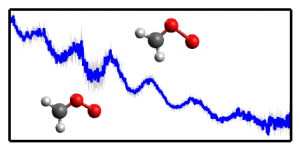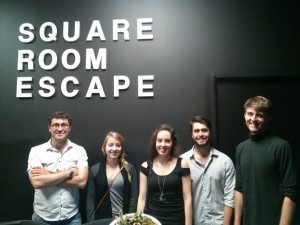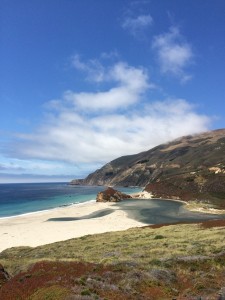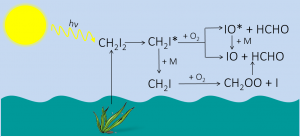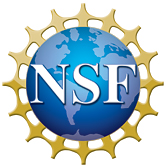 We have been awarded $396,693 by the Chemistry Divison of the National Science Foundation for a three-year project titled, “Unravelling Unconventional photochemistry using time- and state-resolved imaging.” The grant will support our fundamental photochemistry research, in which we use velocity-map ion imaging to explore ‘unusual’ photochemical mechanisms in small molecules.
We have been awarded $396,693 by the Chemistry Divison of the National Science Foundation for a three-year project titled, “Unravelling Unconventional photochemistry using time- and state-resolved imaging.” The grant will support our fundamental photochemistry research, in which we use velocity-map ion imaging to explore ‘unusual’ photochemical mechanisms in small molecules.
OCS PHOFEX paper published in J. Phys. Chem. A
 Our new paper published in J. Phys. Chem. A uses PHOtoFragment EXcitation (PHOFEX) spectroscopy to pick apart the first absorption band of OCS, the most abundant sulfur-containing molecule in the atmosphere. The PHOFEX spectra obtained probing electronically excited S(1D) and ground state S(3P) atoms are distinctly different; the former is broad and unstructured, while the latter shows distinct resonances that can be attributed to vibrational structure following direct excitation of a quasi-bound triplet state.
Our new paper published in J. Phys. Chem. A uses PHOtoFragment EXcitation (PHOFEX) spectroscopy to pick apart the first absorption band of OCS, the most abundant sulfur-containing molecule in the atmosphere. The PHOFEX spectra obtained probing electronically excited S(1D) and ground state S(3P) atoms are distinctly different; the former is broad and unstructured, while the latter shows distinct resonances that can be attributed to vibrational structure following direct excitation of a quasi-bound triplet state.
The article can be found here: 10.1021/acs.jpca.6b06060
“Hot Paper” in Angewandte Chemie
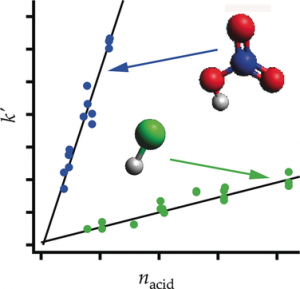
Our new paper on the kinetics of reactions between the simplest Criegee intermediate, CH2OO, and the inorganic acids HCl and HNO3 has been published as a “hot paper” in Angewandte Chemie International Edition. The reaction with HNO3 in particular is likely to be an important sink in polluted environments. You can read it here: 10.1002/anie.201604662
UPDATE: A news article highlighting our paper has been published on ChemistryViews.
ACS PRF New Directions grant
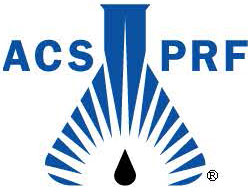 We have been awarded a New Directions grant from the American Chemical Society’s Petroleum Research Fund. The $110,000 award will provide seed funding for a new project titled, “Vibrational Pre-Reactivity: Exploiting Complexes to Probe Reactive Resonances.” We will combine molecular beam techniques with velocity-map ion imaging to study the dynamics of vibrational pre-reaction in atom-molecule van der Waals complexes.
We have been awarded a New Directions grant from the American Chemical Society’s Petroleum Research Fund. The $110,000 award will provide seed funding for a new project titled, “Vibrational Pre-Reactivity: Exploiting Complexes to Probe Reactive Resonances.” We will combine molecular beam techniques with velocity-map ion imaging to study the dynamics of vibrational pre-reaction in atom-molecule van der Waals complexes.
SCURC prize for Vahe
Congratulations to Vahe, who won a Best Oral Presentation prize at the Southern California Undergraduate Research Conference held at CSU Long Beach on April 23. He impressed the judges with his talk describing the application of cavity ring-down spectroscopy to probe non-thermal chemical reactivity.
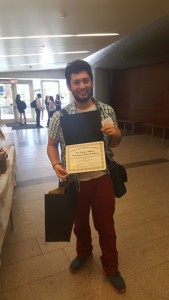
Pair of papers in PCCP
We have two new papers published online in PCCP this week.
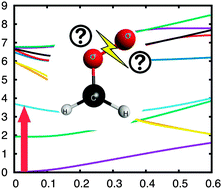
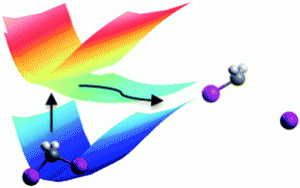 The first is another collaborative paper with UCI colleague Prof. Benny Gerber and his University of Helsinki team, that follows up on our work on the spectroscopy of the simplest Criegee intermediate, CH2OO. It describes trajectory calculations that explore the excited state dynamics. Read it here: 10.1039/c6cp00807k
The first is another collaborative paper with UCI colleague Prof. Benny Gerber and his University of Helsinki team, that follows up on our work on the spectroscopy of the simplest Criegee intermediate, CH2OO. It describes trajectory calculations that explore the excited state dynamics. Read it here: 10.1039/c6cp00807k
The second paper describes a velocity-map ion imaging study of the photodissociation dynamics of diiodomethane (CH2I2). Experimental measurements are interpreted with the help of high-level ab initio calculations by Dr. Grant Hill of the University of Sheffield. Read it here: 10.1039/c6cp01063f
Criegee intermediate spectroscopy paper published in PCCP
Our paper on the spectroscopy of the simplest Criegee intermediate, produced in collaboration with UCI colleague Prof. Benny Gerber, has been published in Phys. Chem. Chem. Phys. We have used broadband absorption and cavity ring-down spectroscopy to measure absolute (and temperature-dependent) absorption cross sections for CH2OO in the visible/near UV.
The article can be found here: 10.1039/C5CP04977F
Group escapade
We spent an hour yesterday evening trying to escape from a locked room. Yes, this is a thing. The group’s intellectual might (and intimate knowledge of all things Harry Potter) was unleashed to tackle a fiendish series of puzzles in order to, well, open a door. Which we failed to do.
Thanks to the kind people at squareroomescape.com for generously allowing us a couple of bonus minutes to save face.
Summer 2015 conferences
We’ve been getting around this summer presenting our work at several meetings.
In June, Liz attended the 11th International User Meeting and Summer School on Cavity Enhanced Spectroscopy held in Boulder, CO. She presented a poster on her recently published work using cavity ring-down spectroscopy to probe the kinetics of the CH2I + O2 reaction.
In July, Ben attended the 25th Conference on the Dynamics of Molecular Collisions held in Asilomar, CA, presenting a poster on his soon-to-be-submitted work on CH2I2 photodissociation dynamics, studied using velocity-map ion imaging.
Finally, I was invited to speak at the 33rd International Symposium on Free Radicals held in August in Squaw Valley, CA. I spoke about various topics related to the formerly elusive, but now ubiquitous Criegee intermediate and presented a poster summarizing some of Ben’s new work on the photochemistry of OCS. I have no pictures of the meeting itself, but I did meet a bear on the way.
Meanwhile, Kara spent her summer in the office learning how to use Molpro. Next year…
New paper published in J. Phys. Chem. A
Our first paper on the important CH2I + O2 reaction has been published in J. Phys. Chem. A. We used cavity ring-down spectroscopy to study the kinetics of IO formation, finding evidence for production both directly and sequentially after first forming CH2OO + I. The direct mechanism appears to depend on the degree of internal energy of the photolytically generated CH2I radical; a cautionary tale for laboratory kinetics studies that use this method to generate radical species.
You can read it here: 10.1021/acs.jpca.5b05058

